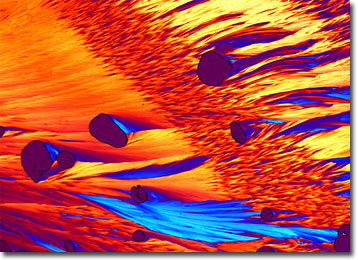Polarized Light Microscopy Digital Image Gallery
Estradiol
Estradiol is one of a group of steroid compounds known as estrogens, which are found in much greater quantities in women than in men. These compounds chiefly function as female sex hormones, playing a key role in the reproductive cycle and the development of secondary sexual characteristics of women.

View a second image of Estradiol
The most physiologically active of the estrogens, estradiol is predominantly produced in the ovaries and metabolized in the liver. The synthesis of the sex hormone often involves the intermediate formation of testosterone, the primary male sex hormone, which is an indication of the close connection between the two steroids. The other main naturally occurring estrogens found in the bodies of humans and mammals are estrone and estriol, both of which can be formed from estradiol. Due to their function in female reproduction, estrogens, especially estradiol, are commonly utilized in oral contraceptives and other substances designed as methods of birth control, such as Depo-Provera.
Menopausal women experience a gradual decrease in the production of estrogens, and the proportions they are synthesized in changes. For instance, though estradiol is the primary estrogen produced during a woman’s reproductive years, females that are no longer fertile generate more of the weaker estrogen, estrone, than estradiol. Due to these significant hormonal changes, which may cause hot flashes and a number of other uncomfortable symptoms, many doctors recommend hormone replacement therapy for post-menopausal women. However, this type of therapy is somewhat controversial since a wide range of side effects have been reported with its use, many of which are more serious than the symptoms the treatment is supposed to help remedy.
